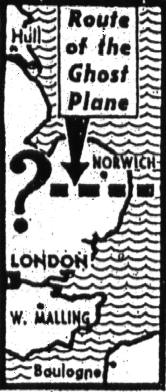Ghost plane
over coast
RAF spot it–can't catch it
By Daily Mail Reporter
A "GHOST" plane which flies in over the East
Anglia coast near Norwich at midnight at great height and disappears
inland is puzzling the Royal Air Force. All attempts at interception
have so far failed.
Crack night-fighter pilots have been sent up in Fighter Commands
latest Mosquitoes, but the mystery aircraft has got away every
time.
It always crosses the coast at roughly the same spot, and it has
used such effective evasive tactics that it is thought to be
equipped with radar to give warning of the approach of intercepting
aircraft.
Time and again, Fighter Command radar operators, plotting the
ghost plane's course over East Anglia, have watched the
"blip" go right across their screen and disappear as
the plane penetrated deep inland.
They have watched vainly for the "trace" to reappear,
moving in the opposite direction, as the plane flew back out
to sea.
Some experts suspect that the plane is engaged in a highly organised
and invisibly financed smuggling operation, using one or more secret
landing places.

According to authoritative information, the plane — of
unidentified type — has a speed of nearly 400 m.p.h. and
a fast rate of climb.
Week's Watch
In Fighter Command operations rooms plotting officers have
invented a nickname for the elusive plane. They call it
"C for Charlie."
Since it was first plotted early in January it has gone down in
official R.A.F. records as "X 362."
The R.A.F. first spotted the plane by accident. A Mosquito
from the night-fighter base at West Mailing, Kent, met it while
flying on a midnight exercise.
The pilot thought the plane was his practice "Target for
Tonight" — and gave chase. It got away.
Fighter Command extended its night radar watch in the
East Anglia area for half an hour a night for more than a week
in the hope of solving the mystery.
The Air Ministry last night said Fighter Command had on two
occasions reported some extraordinary "pilots."
The aircraft concerned had shown an enormous height range
and remarkable speed variations — between 400 and 425 m.p.h.
On the second occasion night-fighter interception was
organised, but no contact was made.
"The possibility of these plots having been due to guided
missiles is discounted," the Air Ministry added.